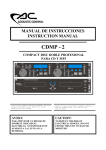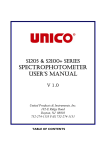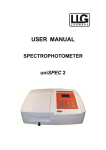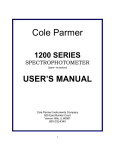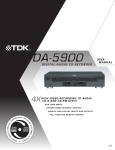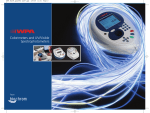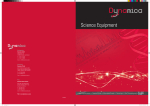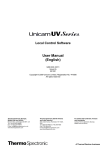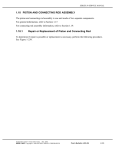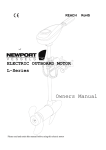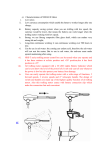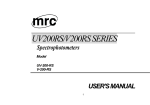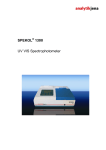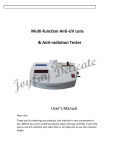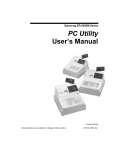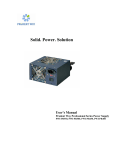Download 1200 SERIES - Masterflex
Transcript
Cole-Parmer 1200 SERIES SPECTROPHOTOMETER USER’S MANUAL Cole Parmer Instruments Company 625 East Bunker Court Vernon Hills, IL 60061 800-323-4340 TABLE OF CONTENTS Page number Safety, General Information ....................................................……….. 3 Introduction .....................................................…………………….. 4 Working Principle.............................................................……………... 5 Unpacking Instructions .....................................................……………. 5 Specifications ...................................................................………..… 6 Installation ..............................................................................………. 6 Basic Operation ..........................................................……………..… 7 Concentration Mode, Factor Mode Modes and function …………………………………… 8 …………………………………………………… 10 Maintenance Lamp replacement ……………………………………………… Wavelength Calibration Check ………………….………………. Absorbance Accuracy Checks……………………………………. Stray Light Check………………………………………………….. 11 11 13 14 Troubleshooting.........................................................................……… 15 2 Safety This apparatus has been designed and tested in accordance with EN 61010 Safety Requirements for Electrical Equipment for Measurement, Control, and Laboratory Use, and has been supplied in a safe condition. The safety statements in this manual comply with the requirements of the HEALTH AND SAFETY AT WORK ACT, 1974. Read the following before installing and using the instrument and its accessories. General The apparatus described in this manual is designed to be used by properly trained personnel in a suitable equipped laboratory. For the correct and safe use of this apparatus it is essential that laboratory personnel follow generally accepted safe procedures in addition to the safety precautions called for in this manual. The covers on this instrument may be removed for servicing. However, the inside of the power supply unit is a hazardous area and its cover should not be removed under any circumstances. There are no serviceable components inside this power supply unit. Some of the chemicals used in spectrophotometry are corrosive and/or inflammable and samples may be radioactive, toxic, or potentially infective. Care should be taken to follow the normal laboratory procedures for handling chemicals and samples. Electrical Before switching on the apparatus, make sure it is set to the voltage of the local power supply (see Installation). The mains plug shall be inserted in a socket provided with a protective earth contact. The protective action must not be negated by the use of an extension cord without a protective conductor. Warning Any interruption of the protective conductor inside or outside the apparatus or disconnection of the protective earth terminal is likely to make the apparatus dangerous. Intentional interruption is prohibited. Whenever it is likely that the protection has been impaired, the apparatus shall be made inoperative and be secured against any unintended operation. 3 The protection is likely to be impaired if, for example, the apparatus • • • • Shows visible damage Fails to perform the intended measurements Has been subjected to prolonged storage under unfavorable conditions Has been subjected to severe transport stresses Performance To ensure that the instrument is working within its specification, especially when making measurements of an important nature, carry out performance checks with particular reference to wavelength and absorbance accuracy. Performance checks are detailed in this manual. Radio Interference For compliance with the EMC standards referred to in the EC Declaration of Conformity, it is necessary that only shielded cables supplied by Cole Parmer be used when connecting the instrument to computers and accessories. Introduction The Cole Parmer 1200 series are single beam, general purpose instruments designed to meet the needs of the Conventional Laboratory, The Cole Parmer 1200 is ideal for various applications, such as: Clinical Chemistry, Biochemistry, Petrochemistry, Environmental Protection, Food and Beverage Labs, Water and Waste Water Labs and other fields of quality control. Featuring a digital display of photometric result, easy operation and wavelength range of 325nm to 1000nm, these instruments are ideal for measurements in the visible wavelength region of the electromagnetic spectrum. Working Principle The spectrophotometer consists of five parts: 1) Halogen lamp to supply the light; 2) A Monochromator to isolate the wavelength of interest and eliminate the unwanted second order radiation; 3) A sample compartment to accommodate the sample solution; 4) A detector to receive the transmitted light and convert it to an electrical signal; and 5) A digital display to indicate absorbance or transmittance. 4 The block diagram below illustrates the relationship between these parts. Block diagram for the Spectrophotometer 100%T 0 A Light Source Monochromator Sample Compartment Detector Display In your spectrophotometer, light from the lamp is focused on the entrance slit of the monochromator where the collimating mirror directs the beam onto the grating. The grating disperses the light beam to produce the spectrum, a portion of which is focused on the exit slit of the monochromator by a collimating mirror. From here the beam is passed to a sample compartment through one of the filters, which helps to eliminate unwanted second order radiation from the diffraction grating. Upon leaving the sample compartment, the beam is passed to the silicon photodiode detector and causes the detector to produce an electrical signal that is displayed on the digital display. The Cole Parmer 1200 incorporates RS232C output terminal that can be used to interface the spectrophotometer with any computer that has RS-232 port (Application software required). Unpacking Instructions Carefully unpack the contents and check the materials against the following packing list to ensure that you have received everything in good condition: Packing List Description: Quantity Spectrophotometer...........……...................................…………………. Power Cord……………………………………………………………….... 10mm Optical Square Cuvettes................................………………….. Test Tubes (1/2 inch) (Model 1200 only) …………………………….…. V-type test tube holder (8 to 25mm) (Model 1200 only, installed) …… 10mm single square cuvette holder (Model 1200 only) ……………….. 4-position cell holder (Model 1201 only) (installed)…………………….. Dust Cover...................................…….......…..........………………….… Manual................................................……..............……………………. 5 1 1 2 box of 12 1 1 1 1 1 Specifications Wavelength Range Spectral Bandpass Wavelength Accuracy Wavelength Repeatability Stray Radiant Energy Photometric Range Photometric Accuracy Power Requirements Dimensions Weight Model 1200 325-1000nm 5nm Better than 2nm Better than 1nm <0.5 @ 340 and 400nm 0 to 125%T 0 to 2.0 Abs 0 to 1999C ± 1.0%T 115/230V ±10%, 60/50 Hz Switchable 408W X 308D X 185H (mm) 15 lbs(6.8kg) Model 1201 325-1000nm 5nm Better than 2nm Better than 1nm <0.5 @ 340 and 400nm 0 to 125%T 0 to 2.0 Abs 0 to 1999C ± 1.0%T 115/230V ±10%, 60/50 Hz Switchable 408W X 308D X 180H (mm) 15 lbs(6.8kg) Installation: 1. After carefully unpacking the contents, check the materials with the packing list (page 5) to ensure that you have received everything in good condition. 2. Place the instrument in a suitable location away from direct sunlight. In order to have the best performance from your instrument, keep it as far as possible from any strong magnetic or electrical fields or any electrical device that may generate highfrequency fields. Set the unit up in an area that is free of dust, corrosive gases and strong vibrations. 3. Remove any obstructions or materials that could hinder the flow of air under and around the instrument. 4. Select either 230V or 115V on the voltage selector switch illustrated below, to match your local mains voltage supply. 5. Turn on your Cole Parmer 1200 and allow it to warm up for 15 minutes before taking any readings. (Note: picture shows Cole Parmer 1100 series which is similar to 1200 series on the back view. 1200 series has RS-232C Port) 6 Basic Operation: Simple operating instructions are printed on the front panel of your Cole Parmer 1200. A. Prepare the spectrophotometer 1. Turn on the spectrophotometer by pressing the Power Switch (IO). Allow 15 minutes for the instrument to warm up. 2. Select either the %Transmittance or Absorbance operating mode by pressing the %T/A selector button (MODE) until the red light for T or A is on. 3. Select the desired wavelength by turning the wavelength control knob (WAVELENGTH). B. Prepare Sample 4. Make a blank reference solution by filling a clean cuvette (or test tube) half full with distilled or de-ionized water or other specified solvent. Wipe the cuvette with tissue to remove the fingerprints and droplets of liquid. 5. Fit the blank cuvette into the square cuvette adapter and place the adapter in the sample compartment, aligning the guide mark (if present) with the guide mark at the front of the compartment. Close the lid. 7 6. Set 0.000A or 100%T with the (0A/100%T) control button. NOTE: This step fulfills the instruction on the front of the spectrophotometer…(Set Full Scale). 7. Remove the blank cuvette or test tube. Set it aside in the case that you may need to adjust the (0A/100%T) control button later (i.e. change the wavelength). C. Analyze Sample 8. Rinse a second cuvette with a small amount of the sample solution to be tested. Fill the cuvette half full and wipe it. 9. Put the sample cuvette in the sample compartment. Close the lid. 10. Read the %Transmittance or Absorbance from the digital readout window. Remove the sample cuvette or test tube. 11. If you are to test the same sample at other wavelengths, repeat steps 3 to 10 for each wavelength. 12. For each new sample you analyze, repeat steps 2 to 11. Concentration (C) Mode for determining the concentration of unknown samples. NOTE: This method should only be used when the relationship between Absorbance and Concentration is known to be linear. The concentration of the Standard solution used to calibrate the instrument should be higher than the most concentrated sample. 1. 2. 3. 4. 5. 6. Select the desired wavelength by turning the wavelength control knob. Using the MODE button, select Absorbance (A) mode. Insert the cuvette containing the blank solution. Set 0.000A with the (0A/100%T) control button. Using the MODE button, select C (concentration) mode. Insert a cuvette containing a standard solution of known concentration in the sample compartment and adjust the digital readout window to the value of the standard by using the ∧ and ∨ arrows. 7. Press the Enter button. NOTE: If the reading changes, the factor required is too high (i.e. >1999) to be displayed. In this case, divide the concentration by 10, re-select the C mode by successive presses on the Mode button, cycling through the F, %T, and A modes, and follow step 2 above to set the concentration of the standard to the reduced value. 8 8. With the standard concentration set, determine the concentration values of samples with unknown concentration by inserting the sample cuvette into the sample compartment and reading the value direct from the display. 9. To read the value of the multiplier used to convert Abs to Concentration, after measuring all the samples, change the Mode to Factor (F) and read the multiplier from the display. Keep a record of this value for future use. Operational Note: if the mode switch is changed to read Factor or Absorbance, the Concentration (C) reading is “frozen”, and cannot be changed. This requires the operator to re-start at step 1. Factor (F) Mode This is a special mode for measuring concentration values of unknown samples using a previously determined factor to convert Absorbance readings to concentration. 1. 2. 3. 4. After setting the wavelength, and setting zero Abs on the blank solution, using the MODE button, select factor (F) mode. Insert a cuvette containing a sample. Using the ∧and ∨ arrows, set the digital read-out window to the desired value of the multiplier. Press the ENT button. The spectrophotometer switches to the Concentration (C) MODE. Operational Note: If the Concentration of the sample is too high to be displayed, the instrument will not switch to Concentration Mode when the ENT button is pressed. Dilute the sample and multiply the concentration reading by the dilution factor to obtain the original sample concentration. 5. 6. Read the concentration value of the sample direct from the display. Insert a cuvette containing the next sample and read the result. Repeat until all samples have been measured. Operational Note: If the MODE switch is changed to A or T, then the concentration reading is “frozen”. This requires the operator to re-start at step 1. 9 Model 1200 Spectrophotometer: Mode Indicator: Allows the operator to know the measurement mode currently in use (%Transmittance, Absorbance). MODE Button: Switches between %Transmittance and Absorbance operating modes at any time of measurement. 0A/100%T Button: Adjusts digital readout to 100%T or 0.000A when blank reference solution is in sample compartment. 0%T Button: When mode is set in transmittance (T) mode and solid block blocks the beam, press the button to adjust readout to 00.0%T. (Note: The light beam must be blocked before pressing this bottom!) PRINT Button (ENT): First press after selecting Concentration mode enters reading on 10 digital readout. Other presses cause output of reading to printer. If using Application Software, press this button to communicate with software. If operating in Factor (F) Mode, then press to enter factor. This causes the Mode to enter the factor number and change to Concentration mode. Sample Compartment: This large compartment can accommodate different cell holders. Model 1200 has V-type test tube holder installed. To replace V-type holder with a 10mm single square cuvette holder, simply remove the top portion of the V-type holder assembly and install the square cuvette holder to the same universal base. Model 1201 has a 4-position cell holder installed. Wavelength Control Knob (WAVELENGTH): Selects desired wavelength in nanometers (nm). Wavelength Readout Window: Displays desired wavelength. Maintenance: A. TO REPLACE HALOGEN LAMP: 1. Turn off and unplug the instrument. Turn the instrument upside down. 2. Remove the grill plate on bottom of the instrument by removing fixing screw. 3. Unplug the lamp from the white connector. Insert the new lamp, pushing it in as far as it will go. Replacement lamp: Part Number: 1200-505 (6V 20W G4 type) CAUTION: DO NOT HANDLE THE LAMP WITH BARE FINGERS. USE TISSUE OR CLOTH WHEN HANDLING LAMP. 4. Turn on the instrument. Set the wavelength at 340nm, leave the sample compartment empty and blank the instrument. If the energy is low, adjust the lamp by “pulling” or “pushing” it. Since the lamp socket is pre-aligned, there will be minimum, if any, adjustment required. 6. Re-install the grill plate. Wavelength Calibration: Normally the Cole Parmer 1200 Series spectrophotometer retains its wavelength calibration indefinitely. However if the instrument receives a severe shock or is abused, use the following methods to check wavelength calibration. Please note that this test requires the Cole Parmer Didymium filter, p/n 1100-110, or the Holmium Oxide filter, p/n 1100-109. 11 In the filter method, the didymium filter has two distinct absorbance peaks at 529nm and 807nm. The Holmium filter has a distinct peak at 361nm. When the instrument is calibrated properly you will find minimum Transmittance (maximum Absorbance) at the range ±2nm from these peaks. Note that the specific Transmittance values are not important as you are only looking for the wavelength where the minimum transmittance (maximum Absorbance) occurs. Holmium Oxide Filter Method: 1. Turn instrument on and allow it to warm up for 15 minutes. 2. Select the Absorbance operating mode. 2. Set the wavelength to 350nm. 3. Make sure the cuvette holder is empty and place it in the sample compartment. Close the sample compartment lid. 4. Set zero Absorbance by pressing the 0A/100%T. Wait a few seconds while the display flashes ‘BLA’. The reading should then be 0.000A. If not, repeat step 5. 5. Remove the cuvette holder and insert the Holmium filter into it. Place it in the sample compartment and close the lid. 6. Record the Absorbance reading on the digital display. 7. Advance the wavelength setting by 1nm and repeat steps 4 to 7. 8. Repeat step 8 until the wavelength setting reaches 370nm. 9. Look for the maximum absorbance reading obtained, and this should be found between 359 and 363nm. The wavelength accuracy of the 1200 is ± 2nm. Didymium Filter Method: 1. Set the Wavelength to 800 nm. 2. Make sure the cuvette holder is empty and place it in the sample compartment. Close the sample compartment lid. 3. Set zero Abs by pressing the 0A/100%T. Wait a few seconds while the display flashes ‘BLA’. The reading should then be 0.000A. If not, repeat step 3. 4. Remove the cuvette holder and insert the Didymium filter into it. Place it in the sample compartment and close the lid. 5. Record the Absorbance reading on the digital display. 12 6. Advance the wavelength setting by 1nm and repeat steps 2 to 5. 7. Repeat step 6 until the wavelength setting reaches 815nm. 8. Look for the maximum absorbance reading obtained, and this should be found between 805 and 809nm. The wavelength accuracy of the 1200 is ± 2nm. 9. If a “middle” wavelength check is desired, set the wavelength to 522nm (optional) 10. Make sure the cuvette holder is empty and place it in the sample compartment. Close the sample lid. 11. Set zero Abs by pressing the 0A/100%T button. Wait a few seconds while the display flashes ‘BLA’. The reading should then be 0.000A. If not repeat step 11. 12. Remove the cuvette holder and insert the Didymium filter into it. Place it in the sample compartment and close the lid. 13. Record the absorbance reading on the digital display. 14. Advance the wavelength setting by 1nm and repeat steps 10 to 13. 15. Repeat step 14 until the wavelength setting reaches 536nm. Again, look for the maximum absorbance reading. It should be between 527 and 531nm. Absorbance Accuracy Checks Specification: ±1% at 1A The absorbance accuracy should be checked against a set of neutral density filters accurately calibrated to the NIST standards. Contact your Cole Parmer representative for more information. An alternative method using potassium dichromate is described below. Due to the many factors that might affect the results (i.e. temperature, bandpass, weighing and diluting errors), this method is less accurate and should only be used as a guide. Reference: Johnson E A Potassium Dichromate as an absorbance standard PSG Bulletin 1967, No. 17, page 505 1. Make up N/100 sulfuric acid as the solvent and use part of it to make a solution containing 120 +0.5mg/litre of potassium dichromate. 2. Wash out a square cuvette with solvent, and fill with solvent. 13 3. Put the cuvette in the adapter into the sample compartment and close the lid. 4. Set the wavelength to 350nm. 5. Set the MODE button to A. 6. Set the reading to 0.000A using the 0A/100%T button. 7. Empty the cell. Wash out with dichromate solution, and fill with dichromate solution. 8. Put the cuvette in the adapter into the sample compartment and close the lid. 9. Read the absorbance of the standard from the display. The value should be 1.288 ±0.04A. Refer to the notes above when interpreting the result. Stray Light Check Specification: Less than 0.5%T at 340nm by ASTM E 387 A good indication as to whether the stray light level is within specification may be obtained as follows: 1. Set the wavelength to 340nm. 2. Set the MODE switch to %T. 3. With the square cell adapter in the sample compartment, but no cell, close the lid and press the 0A/100%T button to set the display to 100.0%. 4. Remove the cell adapter from the sample compartment and close the lid. Make a note of the reading that should be at or near 00.0. 5. Prepare a solution containing 50gm/L of sodium nitrite (NaNO2) in distilled water and fill a square cuvette with this solution. 6. Insert the cuvette into the adapter and place in the sample compartment. Close the lid. The display should read<0.5%T. Note that if the reading obtained in step 4 is greater than 00.0, this value should be subtracted from the displayed reading to give the correct reading for the stray light value. 14 Troubleshooting: PROBLEM Instrument Inoperative Instrument cannot set 100%T (0.000A) Possible Cause Power cord not connected to outlet Dead Power outlet Internal fuse blown or defective electronic component Light beam blocked Lamp is old or defective. Instrument cannot set 100%T (0.000A) (continued…) %T cannot be set to 00.0%T Incorrect Transmittance to Absorbance correlation Digital Display does not change regardless of sample concentration Defective electronic component. Sample compartment open Light beam not blocked Defective electronic component. Bubbles or particles in solution. Defective electronic component. Concentration reading “frozen”. Wrong wavelength setting. Insufficient sample volume. 15 Solution Plug instrument in. Change to a different outlet Call an authorized service engineer. Check sample holder. Test tube or square cuvette adapter must be in sample compartment to open sample holder shutter. Replace lamp. Refer to lamp replacement instructions in this manual. Call an authorized service engineer. Close sample compartment Insert a black block in cell holder to block light beam Call an authorized service engineer. Check sample preparation and analytical procedure. Call an authorized service engineer. MODE switch has been changed from C to F, T or A and back to C. Restart measurement procedure. Check sample procedure and wavelength setting. Fill cuvette with more samples. Stray sample preparation vapors. Bubbles or particles in solution. Digital Display does not change regardless of sample concentration Instrument drift and noise Defective electronic component or loose wiring. Lamp not adjusted properly. Lamp old or defective. Incorrect readings obtained Defective or dirty detector or defective electronic component. Insufficient sample volume Wrong wavelength setting. Stray sample preparation vapors. Bubbles or particles in solution. Instrument out of electronic calibration. 16 Prepare the sample away from the instrument. Use proper ventilation. Check sample preparation and analytical procedure. Call an authorized service engineer. Check lamp has been properly installed or has moved during transit. Refer to lamp replacement instructions in this manual. Replace with a new lamp. Refer to lamp replacement instructions in this manual. Call an authorized service engineer. Fill cuvette with more samples. Check analytical procedure and wavelength setting. Check wavelength accuracy according to procedure in this manual. Prepare sample away from instrument. Use proper ventilation. Check sample preparation and analytical procedure. Call an authorized service engineer.

















